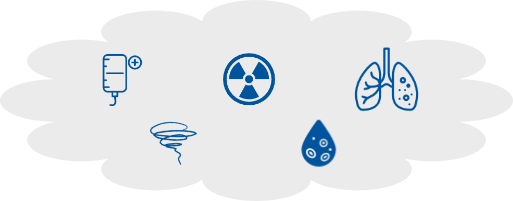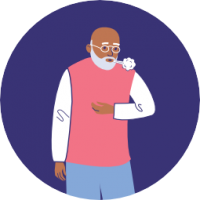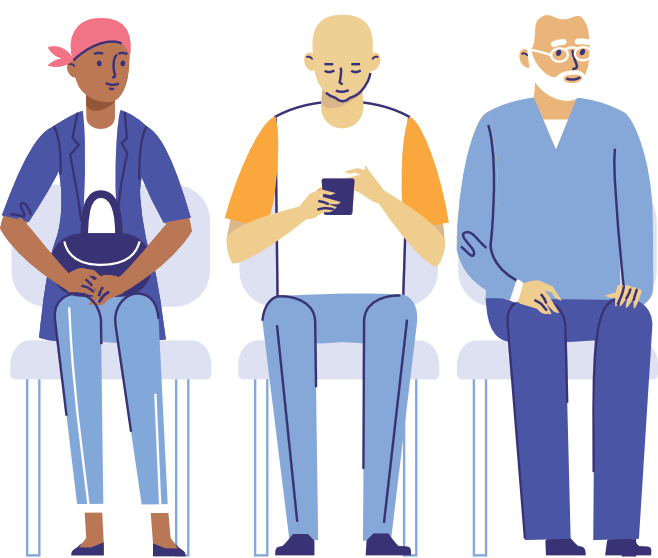Shortness of breath

Topics covered on this page:
What is cancer-related shortness of breath?
Some people with cancer experience shortness of breath (also called breathlessness). This is when you feel like you can’t get enough air into your lungs to breathe normally. The medical name for this is dyspnea. This feeling can be uncomfortable and scary, and may cause you to feel anxious.
- How does it affect me? Shortness of breath may affect how much you can do in a given time. You may find that you need to adjust some of your daily activities to reduce your shortness of breath. There are strategies to help with this (see the section What can I do to help manage my shortness of breath?).
- Does it get better? Sometimes the cause of shortness of breath can be treated. In other cases, if your lung tissue is scarred because of surgery or radiation, the shortness of breath may not go away. But there are medications that can reduce the feeling of breathlessness, as well as different strategies you can use to help you breathe more normally.

What causes shortness of breath?
Common reasons you might feel shortness of breath include:
- The side effects from chemotherapy or radiation therapy.
- The cancer itself. Some cancers increase the chances that you may feel shortness of breath. These include lung cancer, mesothelioma or other cancers that have spread to the lungs.
- Lung infection such as pneumonia.
- Lung diseases, such as Chronic Obstructive Pulmonary Disease (COPD) or asthma, with your cancer.
- General weakness or fatigue due to cancer and its treatment.
- Low red blood cell count as a result of some cancer treatments.
- Anxiety and stress about your cancer and treatment.
- The stress of having difficulty breathing can make your shortness of breath worse by causing your muscles to tense up and your breathing to get faster and shallower.

What are the signs of shortness of breath?
You may experience any of the following when you have shortness of breath:
- Trouble catching your breath
- Feeling like you have to work hard to breathe
- Wheezing or coughing
- Trouble sleeping because of your breathing
- Breathing quickly or a fast heartbeat
- Shortness of breath no matter how small the physical activity

When should I get help for my shortness of breath?
Let your oncologist, your nurse, or your pivot nurse know immediately that you have shortness of breath (for more information see Talking to your healthcare professional about your symptoms or concerns). They can evaluate your symptoms and decide on the best course of action. Call them if any of the following situations are true for you:
- Your breathing has become harder in a short period of time.
- You have a new cough or your cough is getting worse.
- You have pain when you cough.
- You have noisy breathing.
- Your breathing limits doing normal activities, like preparing meals, or grocery shopping.
Call 911 or go to the Emergency department if:
- You are dizzy and you feel like your heart is beating too fast.
- You have new or increasing chest pain.
- You have sudden shortness of breath when waking up.
- You have a fever or weakness with shortness of breath.
- You are wheezing.
- It is hard for you to talk or have a conversation.
What can I do to help manage my shortness of breath?
The following strategies can help you manage your shortness of breath. Try to practice them when you are not breathless. This will give you confidence to cope when you are short of breath.
Keep track of when you are short of breath and how it relates to your cancer or cancer treatment. You can share this information with your healthcare team.
- Write down items such as:
- When did it start?
- What brings it on?
- What does it feel like?
- Can you do your usual activities?
- Are you short of breath with certain activities only?
- What makes it worse?
- What helps?
- For more information see Symptom diary.
You can try different positions that may help you breathe easier. When you feel short of breath, stop what you are doing. Then move into any of these relaxation positions:
- Stand and lean forward on a table. Rest your elbows and lower arms on the table. Keep your back straight.
- Lean your back against a wall with your chin slightly dropped, and your shoulders and arms relaxed and hanging.
- Sit and lean forward with your forearms on your thighs. Keep your feet on the floor and your back straight.
- Elevate the head of your bed with three to four pillows. Lay down on your side (not on your back) so your head is higher than your legs. Make sure your whole side is supported.
- For more information see Relaxation strategies.
Try to practice breathing techniques regularly. This will help you feel more in control of your breathing. It will allow you to remain calmer and recover faster when you are breathless.
- Abdominal breathing:
- Place one hand on your belly
- Count to 4 as you breathe in, feel your belly rise, then breathe out as though you are blowing out a candle, counting 5,6,7,8,9,10
- Repeat this 3 to 4 times
- Practice this 3 times a day
- When you are breathless:
- Move to a relaxation position
- Breathe in through your nose and out through your mouth while focusing on your breath
- Try and blow out a little longer with each breath, this will help you take longer breaths
- Progressively relax tense muscles in the neck, then shoulders and upper chest
You may feel short of breath when you do certain activities, like climbing stairs or walking down the street. This may discourage you from exercising, but it is important to try and stay as active as possible. Inactivity can weaken your muscles. This can make your lungs have to work even harder when you have to move.
- Talk to your healthcare team about how much you should exercise. It is generally fine to exercise during treatment, but check with your healthcare team before starting any exercise.
- Take it slowly when you exercise, and try to breathe using your belly.
- Try activities you can do at home like gardening or vacuuming—exercise doesn’t have to be at a gym!
- Try relaxation activities. Yoga (some types) and tai chi involve slow, meditative movements that help relax the mind and body. Look for classes with trained instructors so that you learn the proper techniques.
- For more information see Get Moving.
- Balance your activities with rest. Rest as much as you need to.
- To help control your shortness of breath, break your activities down into smaller steps. For example, if you are going for a walk, take a break after gathering your shoes and clothes, then take a break after you get dressed. Plan a break during the walk.
- Plan activities ahead of time to save energy. Focus on the activities you enjoy most.
- Try sitting next to a fan or an open window to get extra air when you are feeling out of breath.
- Lower the room temperature—cooler air is easier to breathe.
- Use a humidifier.
- Use pillows to raise your head when lying down.
- Try to avoid heavy perfumes, second hand smoke, flowers, pets, crowded rooms.
- Ask your family and friends to help with activities that have become more difficult for you. They may worry about you feeling short of breath and be happy to help.
- For more information see Getting Support.
⚠ Important information about cannabis
Some patients do use cannabis to reduce pain, help with relaxation or as a sleeping aid. However, the research is still unclear about the use of cannabis to manage cancer-related symptoms, including shortness of breath. It is important to talk to your doctor before trying cannabis. For more information on what cancer patients should know about cannabis, go to: www.bccancer.ca/health-info/coping-with-cancer/medical-cannabis.
Resources
For more information on cancer-related shortness of breath, self-management strategies and support organizations, check out the resources below.
Acknowledgement of sources
The content of this document has been adapted from the following sources:
- BC Cancer. Breathlessness. 2020.
- BC Cancer. Symptom Management guidelines: Dyspnea. 2018.
- Canadian Cancer Society. Difficulty Breathing. 2020.
- Cancer Care Ontario. Shortness of Breath. 2016.
- COSTaRS. Breathlessness/Dyspnea. 2020.
Healthcare professional endorsement
The content of this document has been reviewed and approved by a team of healthcare professionals and clinical experts.
Disclaimer
Please note that this fact sheet is not intended as a substitute for consultation with a healthcare professional. Rather, it was designed to complement interventions by your treating team. If you have questions about your health, or any medical issue, you should contact a healthcare professional right away. You should not delay seeking medical advice, or disregard professional medical advice, because of information in this fact sheet. Before beginning any health treatment, always consult your doctor. All care has been taken to ensure that the information contained in this document is accurate at the time of publication. e-IMPAQc is not responsible for any injury or damage to persons or property arising out of, or related to, any use of the fact sheet, or because of any errors or omissions.
Reproduction and copyright
Any reproduction or distribution, in whole or in part, of this webpage is prohibited without obtaining prior written consent of the e-IMPAQc project lead. Permission can be obtained by writing to e.impaqc.comtl@ssss.gouv.qc.ca.

